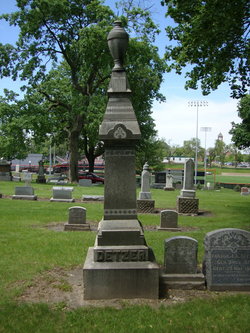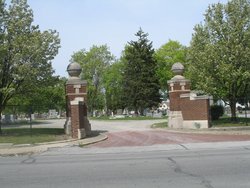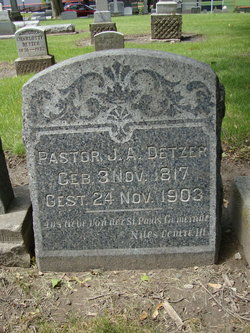 its of prominent citizens of Defiance years ago and illuminating glimpses of how they lived were revealed in a the address by Rev. Fred Detzer of Niles Center, Ill., at St. John's Lutheran church. his historical sketch of Defiance was taken from the diary of Rev. Detzer's father who established the first Lutheran church in Defiance and founded a score of churches in the Northwest Territory.
its of prominent citizens of Defiance years ago and illuminating glimpses of how they lived were revealed in a the address by Rev. Fred Detzer of Niles Center, Ill., at St. John's Lutheran church. his historical sketch of Defiance was taken from the diary of Rev. Detzer's father who established the first Lutheran church in Defiance and founded a score of churches in the Northwest Territory.The primitive mode of living of the pioneer the terrible scourge of cholera that depopulated Defiance in 1854, and the hardships that pastor and people endured together were graphically told by Rev. Detzer.
Scattered through the pages of his father's diary are the names of old settlers. The list is by no means complete, Rev. Detzer explained but it represents the men with whom his father had dealings. Prominent citizens mentioned were Holgate, Tuttle, Buffington, Gleason, Judge Green, Judge Latty, Dr. Thacker, Dr. Colby and Wilhelm, the miller.

Came To Service In Ox Carts
Rev. Detzer Sr., preached his first sermon in Defiance in the old public school building opposite the present Wabash depot (817 Fifth Street) on 9 Feb. 1851. He then preached at 14 mission posts in Northwest Ohio, traveling on horseback over trails, fording streams and at times was forced to return to his home in Williams county because the rivers and creeks were so swollen he could not force his horse across.
One church in Delaware township, so the diary states could only be reached in the summer when the river was low and in the winter when the ice was thick enough to bear a horse.
Because the congregation came long distances, many of them riding in ox carts to the church in Defiance within the memory of Rev. Detzer, the people insisted on getting their money's worth from the preacher and sermons lasting well over an hour and sometime two hours were the rule.
Lining the hymns took much of the preacher's time. He was the only one in the church who had a hymnal, so each stanza was read and the congregation sang, each choosing the tune that best suited his fancy and putting all the wind developed by vigorous exercise with the axe and hoe into the production.
Lists Of Church Members
The first communion service held in Defiance was conducted by Rev. Detzer on Mar. 8 1851. Twenty-nine people took the sacrament. The service on that Sunday lasted from 9 am., till 2 in the afternoon.
In the later part of April, 1851 the congregation issued an informal call to Rev. Detzer and on May 29 of the same year they signed their names to the formal call. The new pastor was installed by Rev. Trautman on Aug. 2. Three weeks later the church officials were elected with Stark as the elder; Warnecke, president; Kussmaul, Vieback, Grass, Frank, trustee. Other names on the church rolls as shown by the pastor's diary were; Koinbaum, Dolke, Flickinger, Boderschatz, Dannenberg. Hess, Grull, Biede, Kreideweiss, Konig, Fritcher, Muller, the canal boat captain, schuiz, Maerz, Andrew, Will and Conrad Martin, Kutzli, M. Goshner, Mohoing, Ludwig, Keamer, Groweg, Biederstadt.
Rode To Fort Wayne For Funds
The pastor and Vieback set out on Oct. 27 to solicit funds for building a church, services having been held in the meantime in the school, where all other denomination but the Methodists were then meeting. They secured "no cash" but promises to pay for $239.
A special collection for the church building taken on Mar. 1 1852 added $1.31 to the fund. With $20 in cash, the church purchased the lot on Washington street where the building now owned by the church of The Brethren stands. The purchase price was $65 and the remaining $45 was borrowed at 16 per cent intest.
Most of the pastor's salary was paid in cord wood, potatoes, hay and other products. The first year he served the Defiance church, Rev. Detzer estimated the value of his salary at $101.81 Though Rev. Detzer preached in Defiance until 187, the highest salary he received from this church was $385.
He moved to the city in June 1853. In October of that year he rode on horseback to Fort Wayne to raise funds for the new church in what was then and now the headquarters of Lutheranism in Northwestern Ohio. He preached at three mission post on route and came home with $65.57 for the new building.
Conducts For Funerals Daily
With no pulpit, pews or other furniture the first service was held in the new church on April 14, 1853. Hewn logs and planks were brought in as seats for the women, the men stood throughout the long sermon. Two weeks later the furniture was in place.
That month cholera broke out in Defiance. It raged for three months. The epidemic reached its height in Septtember with four funerals a day being held in the church on Washington street. Farmers refused to lend wagons or teams to haul the rough boxes used as coffins to the graveyard. They feared the contagion would spread beyond the city.
Conrad Martin was the coffinmaker. The grave digger drank whiskey continully to protect himself from the plague and was the only other person beside Mr. Martin and the Lutheran minister to bury many of the bodies
 Diary Ends in 1856
Diary Ends in 1856
With no hearse and no wagons, the coffins were loaded on two-wheeled dray and huled to the cemetery which was located on the present site of the Presbyterian church. Shallow holes were scooped out of the hillside, according to the diary, in which the rough boxes were hastily buried. Later this part of the cemetery was covered with several feet of soil scraped down from land adjoining the cemetery. When the plague waned, Rev. Detzer came down with cholera.
The diary closes with entries concerning the incorporation of the church in June 1856 and the completion of the parsonage in the same year.
Rev. Detzer remained at his post here until 1872 when the family moved to Chicago. While he served St. Johns's parish, Rev. Detzer founded the churches on the North and South Ridges and at Florida and preached for a time at Napoleon.
He died at the home of his son in Niles Center, Ill., in 1903
Because the congregation came long distances, many of them riding in ox carts to the church in Defiance within the memory of Rev. Detzer, the people insisted on getting their money's worth from the preacher and sermons lasting well over an hour and sometime two hours were the rule.
Lining the hymns took much of the preacher's time. He was the only one in the church who had a hymnal, so each stanza was read and the congregation sang, each choosing the tune that best suited his fancy and putting all the wind developed by vigorous exercise with the axe and hoe into the production.
Lists Of Church Members
The first communion service held in Defiance was conducted by Rev. Detzer on Mar. 8 1851. Twenty-nine people took the sacrament. The service on that Sunday lasted from 9 am., till 2 in the afternoon.
In the later part of April, 1851 the congregation issued an informal call to Rev. Detzer and on May 29 of the same year they signed their names to the formal call. The new pastor was installed by Rev. Trautman on Aug. 2. Three weeks later the church officials were elected with Stark as the elder; Warnecke, president; Kussmaul, Vieback, Grass, Frank, trustee. Other names on the church rolls as shown by the pastor's diary were; Koinbaum, Dolke, Flickinger, Boderschatz, Dannenberg. Hess, Grull, Biede, Kreideweiss, Konig, Fritcher, Muller, the canal boat captain, schuiz, Maerz, Andrew, Will and Conrad Martin, Kutzli, M. Goshner, Mohoing, Ludwig, Keamer, Groweg, Biederstadt.
Rode To Fort Wayne For Funds
The pastor and Vieback set out on Oct. 27 to solicit funds for building a church, services having been held in the meantime in the school, where all other denomination but the Methodists were then meeting. They secured "no cash" but promises to pay for $239.
A special collection for the church building taken on Mar. 1 1852 added $1.31 to the fund. With $20 in cash, the church purchased the lot on Washington street where the building now owned by the church of The Brethren stands. The purchase price was $65 and the remaining $45 was borrowed at 16 per cent intest.
Most of the pastor's salary was paid in cord wood, potatoes, hay and other products. The first year he served the Defiance church, Rev. Detzer estimated the value of his salary at $101.81 Though Rev. Detzer preached in Defiance until 187, the highest salary he received from this church was $385.
He moved to the city in June 1853. In October of that year he rode on horseback to Fort Wayne to raise funds for the new church in what was then and now the headquarters of Lutheranism in Northwestern Ohio. He preached at three mission post on route and came home with $65.57 for the new building.
Conducts For Funerals Daily
With no pulpit, pews or other furniture the first service was held in the new church on April 14, 1853. Hewn logs and planks were brought in as seats for the women, the men stood throughout the long sermon. Two weeks later the furniture was in place.
That month cholera broke out in Defiance. It raged for three months. The epidemic reached its height in Septtember with four funerals a day being held in the church on Washington street. Farmers refused to lend wagons or teams to haul the rough boxes used as coffins to the graveyard. They feared the contagion would spread beyond the city.
Conrad Martin was the coffinmaker. The grave digger drank whiskey continully to protect himself from the plague and was the only other person beside Mr. Martin and the Lutheran minister to bury many of the bodies
 |
 Diary Ends in 1856
Diary Ends in 1856 With no hearse and no wagons, the coffins were loaded on two-wheeled dray and huled to the cemetery which was located on the present site of the Presbyterian church. Shallow holes were scooped out of the hillside, according to the diary, in which the rough boxes were hastily buried. Later this part of the cemetery was covered with several feet of soil scraped down from land adjoining the cemetery. When the plague waned, Rev. Detzer came down with cholera.
The diary closes with entries concerning the incorporation of the church in June 1856 and the completion of the parsonage in the same year.
Rev. Detzer remained at his post here until 1872 when the family moved to Chicago. While he served St. Johns's parish, Rev. Detzer founded the churches on the North and South Ridges and at Florida and preached for a time at Napoleon.
 |
| Cncordia Cemetery. Fort Wayne, Indiana |
He died at the home of his son in Niles Center, Ill., in 1903

No comments:
Post a Comment